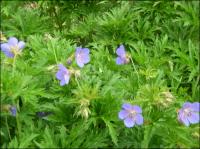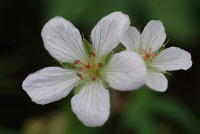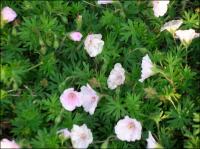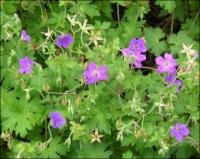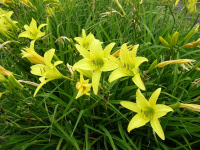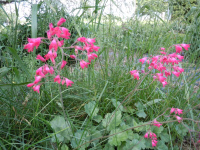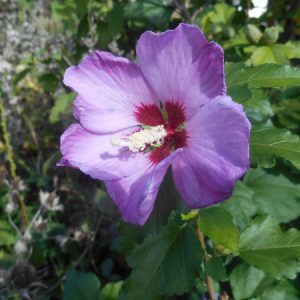Black Walnut Tolerant
Showing 49–56 of 110 results
-
Geranium pratense Meadow Cranesbill Z 3-7
Bluish violet saucer-shaped flowers of oval petals and darker veins to the center, guiding pollinators to its nectar, surrounding dark purple anthers. Bloom in early to midsummer
Bluish violet saucer-shaped flowers of oval petals and darker veins to the center, guiding pollinators to its nectar, surrounding dark purple anthers. Bloom in early to midsummer
Size: 24-36" x 24"
Care: Full sun in moist to moderate well-drained soil
Native: Northern Europe
Wildlife Value: High sugar content in nectar feeds many pollinators. Deer and rabbit resistant.Geranium is Greek meaning “crane” referring to the shape of its seed resembling the bill of a crane. G. pratense was widely cultivated in Europe by 1500’s. In 1629 John Parkinson described the uses of the Cranesbill for: “great wound herbes, and effectual to stay bleedings…[Germans] extoll it wonderfully, for a singular remedy against the stone, both in the reines and bladder.”
-
Geranium richardsonii Richardson’s geranium Z 3-9
White saucer-shaped flower of five oval petals with purple veins to the center, guiding pollinators to its nectar, flowering in spring to early summer
White saucer-shaped flower of five oval petals with purple veins to the center, guiding pollinators to its nectar, flowering in spring to early summer.
Size: 18” x 18”
Care: part sun to shade in moist to moist well-drained soil
Native: All western Canada south to California, Arizona and New MexicoGeranium is Greek meaning “crane” referring to the shape of its seed resembling the bill of a crane. Cheyenne cured nosebleeds with this plant and Navajo considered it a “life medicine.” 1st collected by Thomas Drummond (1780-1835) in the Canadian Rockies. Drummond collected on the Franklin Expedition in Canada, then in Colorado and Texas before dying mysteriously in Cuba.
-
Geranium sanguineum var. lancastriense syn var. striatum Bloody Cranesbill Z 5-8
Pale pink saucer-shaped flowers of five oval petals with darker veins to the center, guiding pollinators to its nectar. Bloom in early to mid-summer
OUT OF STOCK
Pale pink saucer-shaped flowers of five oval petals with darker veins to the center, guiding pollinators to its nectar. Bloom in early to mid-summer
Size: 8" x12"
Care: sun to part shade, moist well-drained soil.
Native: Walney Island, Cumbria England
Wildlife Value: Feeds pollinatorsGeranium is Greek meaning “crane” referring to the shape of its seed resembling the bill of a crane. Sanguinium refers to the red color of the leaves in autumn. This variety discovered on Walney Island in 1732. Walney Island, a small island off the NW coast of England in the Irish Sea, is in Lancaster County. In cultivation in the U.S. since the 1800’s.
-
Geranium wlassovianum Wlassov’s cranesbill Z 4-8
Flowers dusky violet with white eyes, June to September, non-stop. Ornamental, lobed leaves, red in spring & fall.
Flowers dusky violet oval petals and darker purple veins leading to white eye in center showcasing, purple stamens. Blooms June to July and sporadically through August. Ornamental, lobed leaves, red in spring.
Size: 24" x 24"
Care: sun to part shade in moist to moist well-drained soil.
Native: Siberia, Russia, Mongolia & China
Awards: Elizabeth Carey Miller Botanic Garden, Great Plant Award.Geranium is Greek meaning “crane” referring to the shape of its seed resembling the bill of a crane. This species described and named before 1822 by Frederich Ernst Ludwig von Fischer (1782-1854), German doctor, and director of Imperial Botanic Garden in St. Petersburg.
-
Geranium x ibericum – Johnson’s Blue Z 3-8
Long blooming (July to September) if sheared back after 1st flowering, blue flowered saucers & in fall brilliant crimson foliage.
Long blooming (July to September) if sheared back after 1st flowering, blue flowered saucers & in fall brilliant crimson foliage.
Size: 18” x 15”
Care: sun to part shade in moist well-drained soil
Awards: Royal Horticultural Society Award of Garden Merit.Cross of G. himalayense and G. pretense bred by A.T. Johnson, schoolmaster, writer & photographer, in his garden in Conwy Valley, Wales in 1945.
-
Hemerocallis ‘Hyperion’
Midsummer, fragrant lemon yellow trumpets
Midsummer, fragrant lemon yellow trumpets
Size: 36" x 12"
Care: Sun, moist well-drained soil. Drought tolerant.Hybrid origin, bred in 1925 and still popular today.
-
Heuchera sanguinea Coral bells, Alumroot Z 3-8
Coral red flowers in late spring through early summer. “One of the finest hardy perennials recently introduced …bright crimson flowers…very graceful,” Farquhar Catalog, 1893.
Coral red flowers in late spring through early summer. “One of the finest hardy perennials recently introduced …bright crimson flowers…very graceful,” Farquhar Catalog, 1893.
Size: 12" x 12"
Care: sun to part shade in moist well-drained soil.
Native: Western U.S.- Rocky MountainsGenus Heuchera named for Johann Heinrich von Heucher (1677-1747) professor of medicine at Wittenburg University. This species collected Be Dr. Frederick Adolph Wislizenus in the Porphyry Mountains of Llanos Mexico on the Col. Doiphan Expedition in 1846-7. Named by Dr. George Engelmann, (1809-1884) physician and avid botanist encouraging and supporting those who explored for plants. He emigrated from Germany and settled in St. Louis. Plant popular in the 1880’s.
-
Hibiscus syriacus Rose of Sharon Z 5-9
Bodacious blooms of white and magenta July to September
Bodacious blooms of white and magenta July to September
Can not ship to: Georgia, Maryland, Mississippi, Virginia and West Virginia
Size: 8-10’ x 6-8’
Care: sun to part shade in most any soil.
Native: China and India
Wildlife Value: pollinated by hummingbirds, bees and butterfliesGrown in the Eichstätt Garden, the garden of Johann Konrad von Gemmingen, prince bishop of Eichstätt in Bavaria, c. 1600. Grown by Tradescant the Elder in England – 1634. Chinese used the flowers and leaves to make tea. George Washington planted these near the serpentine bowling alley at Mount Vernon. Grown at America’s 1st botanic garden, Elgin Botanic Garden 1811.
**LISTED AS OUT OF STOCK BECAUSE WE DO NOT SHIP THIS ITEM. IT IS AVAILABLE FOR PURCHASE AT OUR RETAIL LOCATION.

